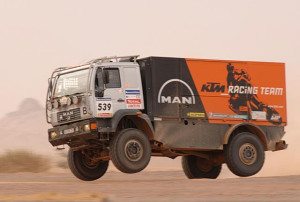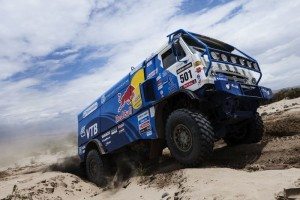
Q.
Can anyone explain the water carrier thing to me?
While lurking on adventurebikerider.com recently, I stumbled across this question on an almost 4 year old thread. I liked the reply to the post, so after a quick back-and-forth with MAD COW (aka blogger Tony Ferrari) who gave the go-ahead to repost.
A.
In simple terms: the water carrier is a team member prepared to provide assistance to his team leader at the cost of his own ambitions – if necessary by sacrificing wheels or other parts from his bike or possibly to step into the leaders place if they are forced to quit the event.
So why “Water Carrier” (which they don’t actually do)? To explain properly we have to look at the history of where the term comes from.
It comes from bicycle racing where the team members are there just to support the team leader. Road cycling is an individual competition but is only won through the entire teams’ effort. The team member’s job includes dropping back to the team car to collect water bottles (they stuff their jerseys full of them) and then riding back up to the peloton (the pack) to distribute them to the leader and other team members hence the water carrier tag.
However, the title actually used in cycling is “domestique” (literally translated as “Servant”) and duties include offering up their wheels if the team leader punctures a tire – or indeed their whole bike (not allowed in motorcycling) then to wait for the team car for a replacement, obviously at the cost of their own position in the race. And of course if a domestique finds himself in front of the team leader his job is to hold back or even wait for them. So why do it? Well it is a role for up-and-coming riders to learn their craft and if they serve well they can get promoted, perhaps one day to become a team leader. In any case you want your principal to win as it is traditional in cycling for the winner to share his winnings with the entire team (the prize in the Tour de France is 450,000 Euros!).
In Rally Racing the role is similar. The Water Carrier is obviously not allowed to win at the cost of his team leader but will likely be in a fairly good position to take up the mantle if the leader has to pull out (e.g. due to injury). Also he is there as a mobile parts bin, anything on his bike (apart from frame or engine cases) can be offered-up to help the leader. Obviously, the Dakar system is slightly different to cycling – e.g. KTM had two principal riders, Coma and Despres, and each had his own Water Carrier. And as was seen when Farres went out, Johnny Aubert (Coma’s Water Carrier) was promoted into the role even though he was a support rider and not a full factory team member.
So what’s the incentive? Well obviously a rider not quite at the top of the game has a choice of riding with a small team with lesser support which might mean not being able to get the win or even finish but at least they can aim for it. Or as a Water Carrier they get a good salary and full factory team support but are unlikely to get the big win. Of course if they serve well and improve, they may get to be promoted, after all even Coma and Despres will retire one day, so it can be worth playing the long game. And if the unthinkable happened and one of them received an injury forcing their withdrawl, the Water Carrier can step up to the mark with the full factory team behind them, suddenly getting their chance to shine.
In the Dakar of old, the reason trucks raced was to provide support on the course. This is the T4 class where support trucks, fully laden with spare parts and tools, would race as competitors in their own right as assistance is allowed between competitors in the special stages.
The T5 class [now the T4.3 class] is for Assistance Trucks who don’t race but take a different route to the special stages (often on tarmac these days) and can only provide assistance in liaison zones or at the bivouac. As the trucks now often use different routes and start so far behind the bikes and cars, T4 has become a pure racing category and very few are there to provide assistance. So to ensure support in the special stages the big teams (which at present is only KTM) moved to the principle of Water Carriers.
KTM T5 Support Truck – 2009 Dakar
Photo: motorcycleusa.com
Now . . . check out the author’s blog. You will not be disappointed!
 The efforts of an unfit, fifty-something trying to go Rally Bike Racing, as well as other assorted exploits.
The efforts of an unfit, fifty-something trying to go Rally Bike Racing, as well as other assorted exploits.




